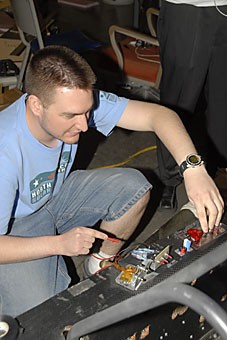Most people who have $250,000 to spend on a car buy a Ferrari or a Porsche – something that will turn heads and melt asphalt on the freeway.
The UA solar car team took the environmental approach, using its $250,000 to construct a sleek, solar cell-plated competition car with a maximum speed of 80 mph.
As part of the North American Solar Challenge, a national solar car endurance race, a group of roughly 75 engineering students has been working out the kinks of its car, Drifter, for the past two years.
Drifter was originally planned to compete in the 2005 NASC race, but logistical issues curbed the team’s chance to participate for at least another two years. Sponsoring problems have forced the normally biannual summer event to postpone the 2007 race until 2008, with no complaints from the UA squad.
Wei-Ren Ng, an electrical engineering senior and co-manager of the group, said the students need all the time they can to fix the car. At the 2005 competition, the UA’s team of engineers ran into a myriad of troubles just before the deadline for entry.
Jarod Prosise, a 2006 graduate of the UA’s computer science and computer engineering program, worked on the 2005 version of the car and acts as a “”consultant”” for electrical issues for the 2008 edition. Prosise said the team had suspension problems that caused tires to blow out on the test track and ran out of time to do repairs, which made them unable to compete.
Taking the same car they planned on using in 2005, the group of students have spent the last two years fixing problems with the car. Tweaking the suspension, which was designed by engineering students in 2001, and trying to maximize the efficiency in which the lithium polymer batteries operate were among their main concerns.
Rick Cook, a computer engineering senior and member of the team for a year and a half, has been working on the battery efficiency monitoring system. Cook said the shortcomings of 2005 left a sour taste in the students’ mouths, but they needed to learn from the mistakes made in the past in order to avoid repeating them in the future.
Cook and Ng said they were able to apply their engineering knowledge to the solar car and gain valuable experience working with solar technology at the same time. Cook said his teamwork skills also improved during his time working on the project.
The students are supported by many sponsors, Ng said. Boeing, Raytheon, Tucson Electric Power, the College of Engineering and former UA president Peter Likins are among the main contributors to the estimated $250,000 cost of the project.
The group is looking for additional assistance with their project, whether through cash donations, material donations or helping work on the car itself. If you’re interested, go to www.solarcar.arizona.edu or e-mail solarcar@email.arizona.edu for more information.
Ng said the bulk of the cost went toward buying the batteries and the solar panels that power the car. Funding issues also contributed to the group deciding to keep the 2005 car and modify it rather than starting from scratch.
Prosise said the 88 solar panels, the same type used on most satellites, totaled $75,000. Each panel varies in size, but each of the 2,720 solar cells is roughly 27 square centimeters, Prosise said. Drifter stands 0.9 meters high, 1.8 meters wide and 5 meters long, and the solar panels cover an area of 8 square meters.
“”It’s hot and uncomfortable,”” Ng said. With only a small hole made for entry to the one-seat vehicle, comfort wasn’t the first priority – it was safety. The driver essentially has to lie down to drive it, or at least sit at about a 45-degree angle, Prosise said.
“”These cars were meant to drive on normal roads, so safety was made the number one priority,”” Ng said. The car was equipped with a roll cage to protect the driver in an accident.
Cook said it was hard to get support for the project because the U.S. runs on oil.
“”People are more interested in power and luxury rather than being environmentally friendly,”” Cook said.
The summer 2008 NASC race should follow the same path as the 2005 race, Prosise said. The 2005 route started in Austin, Texas, and ended more than 2,500 miles away in Calgary, Alberta, Canada.
“”It’s an endurance trial as well as speed,”” Prosise said.
All competition entries will be judged on the car’s overall efficiency, logistics, road-worthiness and other criteria.









